Related Research Articles

An anti-aircraft vehicle, also known as a self-propelled anti-aircraft gun (SPAAG) or self-propelled air defense system (SPAD), is a mobile vehicle with a dedicated anti-aircraft capability.
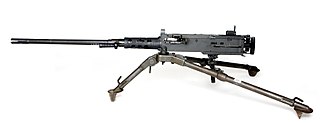
The M2 machine gun or Browning .50 caliber machine gun is a heavy machine gun that was designed near the end of World War I by John Browning. While similar to Browning's earlier M1919 Browning machine gun, which was chambered for the .30-06 cartridge, the M2 uses Browning's larger and more powerful .50 BMG cartridge. The design has had many designations; the official U.S. military designation for the current infantry type is Browning Machine Gun, Cal. .50, M2, HB, Flexible. It is effective against infantry, unarmored or lightly armored vehicles and boats, light fortifications, and low-flying aircraft.

The Vietnam War involved the People's Army of Vietnam (PAVN) or North Vietnamese Army (NVA), National Liberation Front for South Vietnam (NLF) or Viet Cong (VC), and the armed forces of the China (PLA), Army of the Republic of Vietnam (ARVN), United States, Republic of Korea, Philippines, Thailand, and the Australian, New Zealand defence forces, and a variety of irregular troops.

The Bofors 40 mm Automatic Gun L/60 is an anti-aircraft autocannon, designed in the 1930s by the Swedish arms manufacturer AB Bofors. The gun was designed as an intermediate anti-aircraft gun, filling the gap between fast firing close-range small calibre anti-aircraft guns and slower firing long-range high calibre anti-aircraft guns, a role which previously was filled by older outdated guns. The Bofors 40 mm L/60 was for its time perfectly suited for this role and outperformed competing designs in the years leading up to World War II in both effectiveness and reliability.

The 90 mm gun M1/M2/M3 was an American heavy anti-aircraft and anti-tank gun, playing a role similar to the German 8.8cm Flak 18. It had a 3.5 in (90 mm) diameter bore, and a 50 caliber barrel, giving it a length of 15 ft (4.6 m). It was capable of firing a 3.5 in × 23.6 in shell 62,474 ft (19,042 m) horizontally, or a maximum altitude of 43,500 ft (13,300 m).

The DShK 1938 is a Soviet heavy machine gun with a V-shaped butterfly trigger, firing the 12.7×108mm cartridge. The weapon was also used as a heavy infantry machine gun, where it was frequently deployed with a two-wheeled mounting and a single-sheet armour-plate shield. The DShK's name is derived from its original designer, Vasily Degtyaryov, and Georgi Shpagin, who later improved the cartridge feed mechanism. It is sometimes nicknamed Dushka in Russian-speaking countries, from the abbreviation. Alongside the American M2 Browning, the DShK is the only .50 caliber machine gun designed prior to World War II that remains in service to the present day.

The ZU-23-2, also known as ZU-23, is a Soviet towed 23×152 mm anti-aircraft twin-barreled autocannon. ZU stands for Zenitnaya Ustanovka – anti-aircraft mount. The GRAU index is 2A13.
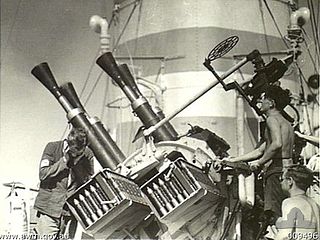
The 2-pounder gun, officially the QF 2-pounder and universally known as the pom-pom, was a 40 mm (1.6 in) British autocannon, used as an anti-aircraft gun by the Royal Navy. The name came from the sound that the original models make when firing. This QF 2-pounder was not the same gun as the Ordnance QF 2-pounder, used by the British Army as an anti-tank gun and a tank gun, although they both fired 2 lb (0.91 kg), 40 mm (1.6 in) projectiles.
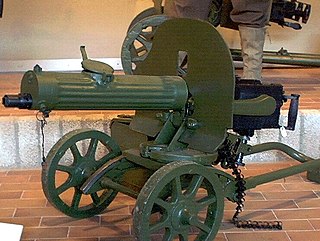
The Pulemyot Maksima PM1910, or PM M1910, is a heavy machine gun that was used by the Imperial Russian Army during World War I and the Red Army during the Russian Civil War and World War II. Later the gun saw service in the Korean War, the Vietnam War and the 2022 Russian invasion of Ukraine.

The ZPU is a family of towed anti-aircraft guns based on the Soviet 14.5×114mm KPV heavy machine gun. It entered service with the Soviet Union in 1949 and is used by over 50 countries worldwide.

The M45 Quadmount was a towed anti-aircraft gun consisting of four .50 caliber M2 Browning machine guns mounted in pairs on either side of an armored open-top gunner's compartment with electrical laying. It was developed by the W. L. Maxson Corporation to replace the earlier M33 twin mount. Although designed as an anti-aircraft weapon, it was also used against ground targets, where it earned the nicknames "meat chopper" and "Krautmower" Introduced in 1944, it saw service as late as the Vietnam War.

The KPV-14.5 heavy machine gun is a Soviet designed 14.5×114mm-caliber heavy machine gun, which first entered service as an infantry weapon in 1949. In the 1960s, the infantry version was taken out of production because it was too large and heavy. It was later redesigned for anti-aircraft use, because it showed excellent results as an AA gun, with a range of 3,000 meters horizontally and 2,000 meters vertically against low flying planes. It was used in the ZPU series of anti-aircraft guns. Its size and power also made it a useful light anti-armour weapon on the BTR series of vehicles and the BRDM-2 scout car.
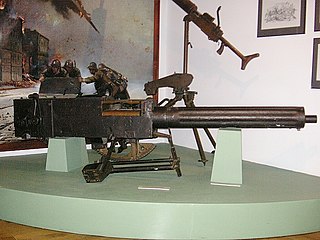
The Vickers .50 machine gun, also known as the 'Vickers .50' was similar to the .303 inches (7.70 mm) Vickers machine gun but enlarged to use a larger-calibre 0.5-inch (12.7 mm) round. It saw some use in tanks and other fighting vehicles but was more commonly used as a close-in anti-aircraft weapon on Royal Navy and Allied ships, typically in a four-gun mounting (UK) or two-gun mounting (Dutch). The Vickers fired British .50 Vickers (12.7×81mm) ammunition, not the better known American .50 BMG (12.7×99mm).
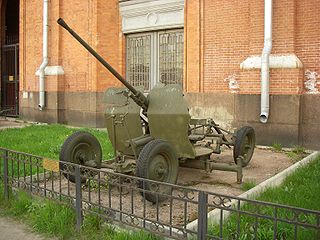
25 mm automatic air defense gun M1940 (72-K) was a Soviet 25 mm caliber anti-aircraft gun used during the Great Patriotic War. The gun was developed from the end of 1939 to the beginning of 1940 at 8th Kalinin Artillery Plant under the guidance of its Chief Designer Mikhail Loginov, supervised by Lev Loktev. The cannon was given the factory code 72-K before being accepted into service by the Red Army as the 25 mm automatic air defense gun M1940.

The QF 1 pounder, universally known as the pom-pom due to the sound of its discharge, was a 37 mm British autocannon, the first of its type in the world. It was used by several countries initially as an infantry gun and later as a light anti-aircraft gun.

The GAZ-AAA was a truck produced by GAZ. From 1936 to 1943, 37,373 units were built. Like the GAZ-AA and GAZ-MM it was largely based on the Ford Model AA truck.

The GAZ-MM is a medium-duty truck produced at the Gorki Auto Plant from 1938 to 1948, and then at the Ulyanovsky Auto Plant, up to 1956. The truck was a modernized variant of the GAZ-AA truck, but using the engine from the GAZ-M1, upgrading the vehicle's power to 50 hp.

The Vz.53 is an anti-aircraft weapon system produced in Czechoslovakia during the 1950s. It combines four Vz.38/46 (DShK) 12.7 mm Machineguns on a wheeled mount with a 360° traverse. It's full Czech designation was 12.7 mm PL štvorguľomet vz.53.
References
- 1 2 "Miniart 1/35 scale Kit No. 35177; GAZ-AAA w/Quad M4 Maxim Review by Cookie Sewell". Missing-lynx.com. Retrieved 4 July 2022.
- ↑ "MiniArt 1/35 GAZ-AAA Truck w/Quad M4 Maxim Gun Kit". Militarymodeldepot.com. Retrieved 4 July 2022.
- ↑ "7.62mm M.1931 4M (ZPU)n". Quartermastersection.com. Retrieved 4 July 2022.
- ↑ "GAZ-AAA with DSHK m.1938". Zebrano-model.com. Retrieved 4 July 2022.
- ↑ "4М-ГАЗ-ААА | World of Man Dreams".